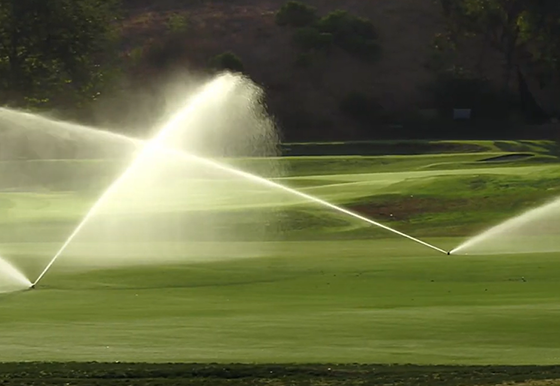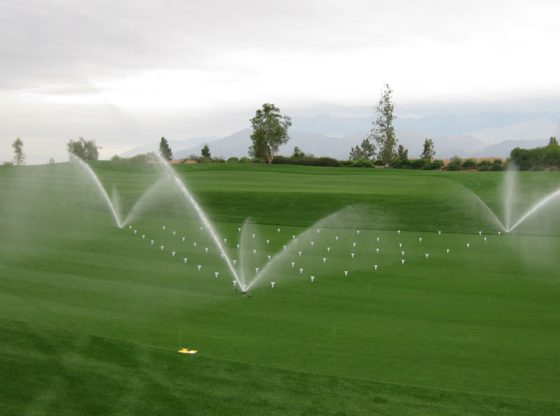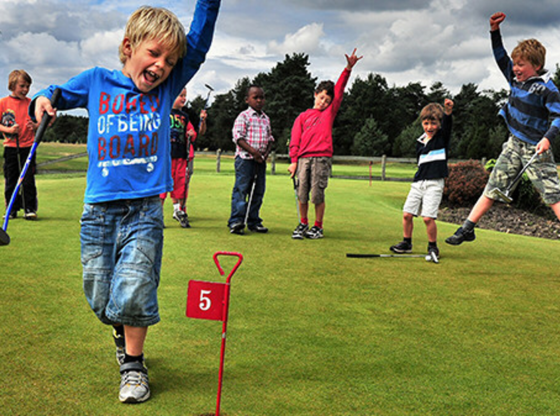In celebration of July being Smart Irrigation Month, golf courses should create better practices for water conservation. According to an environmental fact sheet prepared by the New Hampshire Department of Environmental Services, the following are good practices for irrigation control on golf courses.
Water Efficiency
Golf Courses Irrigation of turf grass is a water-intensive practice, but conservation techniques can help reduce demands on surface and groundwater supplies used for irrigation. Water efficiency practices lower the long-term costs and help ensure sufficient supplies are available for future use and the environment. Irrigation water efficiency practices use techniques that minimize water losses while satisfying turf grass water needs. Water losses typically include evaporation, deep percolation and runoff.
The water conservation practices listed in this fact sheet help control losses through implementation of efficient irrigation technology, effective irrigation scheduling, soil moisture determination and retention, low-flow plumbing and other water-saving practices.
General Water Efficiency Practices
The following general water efficiency practices apply to all areas of the facility.
- Develop a water system maintenance program. Routinely inspect all plumbing fixtures, appliances, pressure regulators, water lines, valves and pumps for leaks. Keep replacement and repair parts on hand. Metering different areas helps to detect leaks.
- Sweep parking lots, driveways, walks, patios, decks and steps rather than hosing them off.
- Turn off water when not in use.
- Recycle water for other purposes whenever possible. For instance, water used to rinse dishes in the kitchen could be piped to a cistern and reused to water landscape plantings.
Irrigation Efficiency
Proper use and maintenance of your sprinkler system can save both water and money. Evaluate the following sprinkler irrigation practices and technologies and incorporate the most efficient and feasible into your irrigation designs.
- Design an irrigation schedule.
- Determine your soil type. Soil characteristics help identify effective irrigation application rates, duration and frequencies.
- Determine weekly precipitation amounts. Install a rain gauge in a central location in an open area where overhanging plant material won’t divert rain from the gauge. Though local radio and TV weather services can give you general precipitation rates for the week; site-specific information will be more accurate. Avoid watering just before a rain event.
- Check soil moisture to determine watering needs. Soil moisture sensors are useful in determining how wet your soil is. In some instances you will find that you do not need to water even if it has not rained recently. Soil moisture can be measured with tensiometers, electrical resistance blocks (“gypsum,” “ceramic” or “moisture” blocks) or neutron probes.
- Determine each turfgrass variety’s water quantity needs. Withholding water at early growth stages can sometimes increase root depths and drought resistance.
- Measure the output from your irrigation devices. Use flow meters or gauged water pans to measure the output of sprinklers and drip irrigation heads.
- Combine the five pieces of information above to determine a week-by-week irrigation schedule outlining irrigation frequency, volume and duration for each type of turf. For example: Irrigation per week = turfgrass water needs per week – present soil moisture – rainfall per week. Update the schedule as weather and soil moisture conditions change. Irrigate so that water penetrates only to the depth of the root zone.
- Recheck soil moisture one to two days after irrigation to determine depth of applied water and uniformity. If water penetration is too deep, too shallow or spotty, adjust your irrigation schedule to correct it.
- Sprinkler heads should be spaced so that excessive overlap does not occur.
- Make sure that sprinkler heads on the same circuit match. Mismatched heads deliver water at different rates and may perform differently. Mixing types of sprinkler heads wastes water.
- Remove any obstructions to the spray pattern.
- Inspect sprinkler nozzles to ensure they are not clogging, are operating properly and distributing the water uniformly.
- Adjust the spray pattern to irrigate only the area desired and avoid overspray onto walkways, pavement and other non-irrigated areas.
- Use pressure regulators to assist with uniform water distribution throughout irrigation systems and evaluate pressure to better control application rates.
- Adjust the pressure or install a new regulator if sprinkler heads are misting.
- Use timers, automatic shut off valves, rain sensors and other such devices to help ensure overwatering does not occur.
- Upgrade, replace or computerize your irrigation system.
- Water at night or early in the morning to reduce evaporation losses.
- Use drip or trickle irrigation where possible.
- Spot water if entire area isn’t dry.
- Eliminate irrigation wherever possible, such as the rough.
- Employ mulches wherever possible.
- Use drought-resistant turfgrasses that require less irrigation and maintenance. Kentucky bluegrass, a popular turfgrass that despite its name was developed in England, needs a moist environment to thrive. Employing this type of grass in golf courses and lawns wastes a great deal of water.
- Incorporate moisture retentive polymers in the soil. Though traditionally used in container plantings, these polymers are presently being tested by some golf courses to cut down on irrigation demands.
To read the full article click here.












